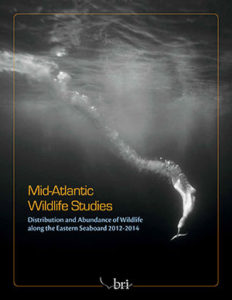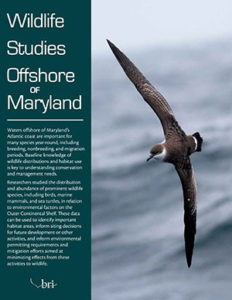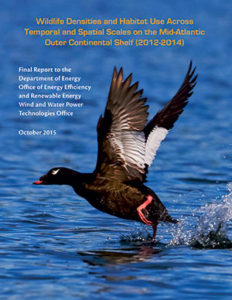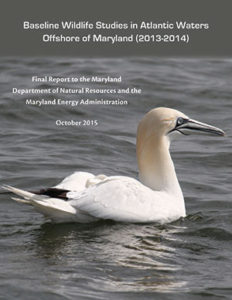Final reports from the the Department of Energy (DOE)-funded Mid-Atlantic Baseline Studies Project (2012-2015) and the state-funded Maryland Project (2013-2015) are available for download below. Other selected reports, publications, presentations, and outreach documents from the two projects are also listed below. Previous annual reports are available on request.

This 32-page publication is a full-color summary of project goals, activities, and findings, and represents an overview of results from the final technical report for the Mid-Atlantic Baseline Studies Project (below). This communications piece explores aspects of the mid-Atlantic ecosystem; describes our survey and analytical approaches; and presents a range of results, featuring several case studies on specific species or phenomena. Each case study includes the integration of data from multiple study components, providing a comprehensive view of wildlife distributions and movement patterns in the mid-Atlantic study area.

Download Wildlife Studies Offshore of Maryland.
This 8-page publication is a full-color summary of project goals, activities, and findings for the Maryland-funded expansion of the Mid-Atlantic Baseline Studies Project. This communications piece represents an overview of results from the final technical report for the Maryland-focused study (below), and features survey results and case studies on marine mammals, sea turtles, and wintering seabirds. Waters offshore of Maryland’s Atlantic coast are important for many species year-round, including breeding, nonbreeding, and migration periods. Baseline knowledge of wildlife distributions and habitat use is key to understanding conservation and management needs.

Wildlife Densities and Habitat Use Across Temporal and Spatial Scales on the Mid-Atlantic Continental Shelf
Full Report—42 MB
Table of Contents and Executive Summary
Chapter 1: Ecosystem background and project activities
Chapter 2: Synthesis of project findings
Introduction to Part II: Examining wildlife distributions and relative abundance from a digital video aerial survey platform
Chapter 3: High resolution digital video aerial survey methods
Chapter 4: High resolution digital video aerial survey data protocols
Chapter 5: Summary of high resolution digital video aerial survey data
Chapter 6: Recommendations for high resolution digital video aerial surveys in the U.S.
Introduction to Part III: Examining wildlife distributions and abundance using boat-based surveys
Chapter 7: Boat survey protocol for Mid-Atlantic Baseline Studies
Chapter 8: Summary of boat survey data
Chapter 9: Monitoring aquatic biomass via hydroacoustics: echo sounding data processing and summary of results
Chapter 10: Spatial association between seabirds and prey on the mid-Atlantic Outer Continental Shelf
Chapter 11: A community distance sampling model to investigate the abundance and distribution of seabirds
Chapter 12: Predicting the offshore distribution and abundance of marine birds from shipboard surveys, using a hierarchical community distance sampling model
Introduction to Part IV: Integrating data across survey platforms
Chapter 13: Integrating novel and historical survey methods: a comparison of standardized boat-based and digital video aerial surveys for marine wildlife in the United States
Chapter 14: Summary of boat and aerial datasets: comparison between survey methods
Chapter 15: Density modeling for marine mammals and sea turtles with environmental covariates
Chapter 16: Modeling species assignment in strip transect surveys with uncertain species identification
Chapter 17: Integrating data across survey methods to identify spatial and temporal patterns in wildlife distributions
Chapter 18: Comparison of boat and aerial models of seabird abundance with environmental covariates
Chapter 19: Developing an integrated model of marine bird distributions with environmental covariates using boat and digital video aerial survey data *This chapter is in draft form
Introduction to Part V: Individual movements and habitat use for focal bird species
Chapter 20: Wintering movements and habitat use of Surf Scoter (Melanitta perspicillata) in the mid-Atlantic U.S.
Chapter 21: Wintering movements and habitat use of Red-throated Loons (Gavia stellata) in the mid-Atlantic U.S.
Chapter 22: Wintering movements and habitat use of Northern Gannets (Morus bassanus) in the mid-Atlantic U.S.
Chapter 23: Incorporating temporal variation in seabird telemetry data: time variant kernel density models
Chapter 24: Using state-space models to identify areas of persistent winter activity and their associated environmental covariates in Northern Gannets
Chapter 25: Offshore migration of Peregrine Falcons (Falco peregrinus) along the Atlantic Flyway
Introduction to Part VI: Nocturnal avian migration
Chapter 26: Passive acoustics pilot study: nocturnal avian
migration in the mid-Atlantic
Chapter 27: Using WSR-88 weather radar to identify patterns of nocturnal avian migration in the offshore environment

Baseline Wildlife Studies in Atlantic Waters Offshore of Maryland
Full Report—28 MB
Table of Contents and Executive Summary
Chapter 1: Ecosystem background and project activities
Chapter 2: Synthesis of project findings
Introduction to Part II: Examining wildlife distributions and relative abundance from a digital video aerial survey platform
Chapter 3: High resolution digital video aerial survey methods
Chapter 4: High resolution digital video aerial survey data protocols
Chapter 5: Summary of digital video aerial survey data
Introduction to Part III: Examining wildlife distributions and abundance using boat surveys
Chapter 6: Boat survey protocol for Mid-Atlantic Baseline Studies and Maryland Projects
Chapter 7: Summary of boat survey data
Chapter 8: Monitoring aquatic biomass via hydroacoustics: echo sounding data processing and summary
Chapter 9: Predicting the offshore distribution and abundance of marine birds from shipboard surveys, using a hierarchical community distance sampling model
Introduction to Part IV: Integrating data across survey methods
Chapter 10: Summary of boat and aerial datasets: comparison between survey methods
Chapter 11: Integrating data across survey methods to identify spatial and temporal patterns in wildlife distributions
Chapter 12: Density modeling for marine mammals and sea turtles with environmental covariates
Chapter 13: Comparison of boat and aerial models of seabird abundance with environmental covariates
Chapter 14: Developing an integrated model of marine bird distributions with environmental covariates using boat and digital video aerial survey data *This chapter is in draft form
Other Documents
Hatch SK, Connelly EE, Divoll TJ, Stenhouse IJ, Williams KA (2013) Offshore observations of eastern red bats (Lasiurus borealis) in the mid-Atlantic United States using multiple survey methods. PLoS One 8(12):e83803. doi:10.1371/journal.pone.0083803.
- Observations of Eastern Red Bats between 16 and 70 km from shore during boat-based and digital video aerial surveys provided new information about this species’ offshore movements, including the flight heights and times of day at which such movements may occur.
Williams KA (2015) Wildlife distributions and habitat use on the mid-Atlantic Outer Continental Shelf.
- Summary presentation that provides a brief overview of project methods and major findings.



